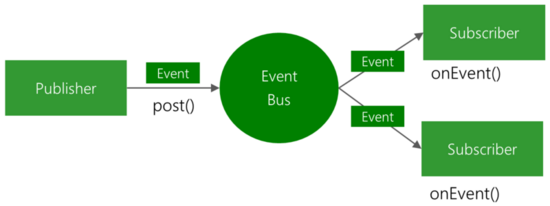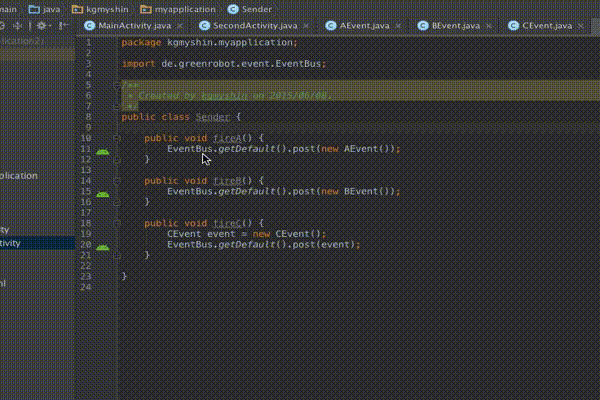簡介
EventBus 是 http://greenrobot.org/ 出的一個 發布者/訂閱者 ( Publisher/Subscriber )的事件總線。主要是用來在 Android 各個組件之間進行消息傳遞的。能夠很好地對發布者和訂閱者之間進行解耦。
下圖是官方給出的一個示意圖:

集成
在項目的 build.gradle 文件中添加如下依賴:
compile 'org.greenrobot:eventbus:3.0.0'
使用
發布者Publisher
我們使用EventBus發布消息的時候很方便,只需要一句話就可以。如下:
EventBus.getDefault().post(quot;helloquot;);
在這里我們發布的可以是基本數據類型,可以是字符串,也可以是對象。
訂閱者Subscriber
當我們需要在一個 Activity 或者 Fragment 中訂閱事件時。我們需要注冊 EventBus
EventBus.getDefault().register(this);
當我們注冊了 EventBus 之后我們就需要取消注冊。一般在 Activity 或 Fragment 銷毀的時候注銷。注銷的代碼如下:
EventBus.getDefault().unregister(this);
@Subscriber
當我們注冊了 EventBus 之后。我們就需要寫一個方法。來對事件進行處理。如下:
@Subscribe
public void test(String strging){
Log.i(quot;tempquot;,quot;printf quot; string);
}
在這里。 EventBus 沒有對函數的命進行規定。只需要加上注解 @Subscribe ,方法為 public void 即可。只要方法的參數跟 post 時的類型一致即可接受到改事件。
實例
比如說現在我們有個需求是。點擊一個按鈕就退出應用程序。那么我們使用EventBus可以怎么實現呢?
首先。我們可以在 BaseActivity 中注冊退出應用程序的時間,讓其他的 Activity 都集成該類。
public class BaseActvity extends AppCompatActivity {
@Override
protected void onCreate(@Nullable Bundle savedInstanceState) {
super.onCreate(savedInstanceState);
EventBus.getDefault().register(this);
}
@Subscribe
public void exitApp(ExitApp exitApp){
finish();
}
@Override
protected void onDestroy() {
super.onDestroy();
EventBus.getDefault().unregister(this);
}
}
這時候我們只需要在按鈕的點擊時間中發送改消息即可了。
EventBus.getDefault().post(new ExistApp());
事件類 ExistApp 可以隨意,這里只是用來表明語義。
@Subscribe(threadMode = xxx)
@Subscriber 函數的線程。此時默認為:
ThreadMode.POSTING
ThreadMode 是一個枚舉類型。它的值有: POSTING , MAIN , BACKGROUND , ASYNC .源碼中的注釋寫的很詳細,見參考中 ThreadMode 的代碼。
簡單的說就是。
-
POSTING:Subscriber在發布消息(調用post函數的線程)的線程中執行。 -
MAIN:Subscriber將在Android主線程中執行。 -
BACKGROUND:Subscriber在后臺線程中執行 -
ASYNC:Subscriber在異步線程,也就是在獨立的線程中執行。
優先級
我們可以通過 @Subscribe(priority = 100) 指定一個Subscriber函數的優先級.默認的優先級是0。高優先級的Subscriber將會優先訂閱事件。
@Subscribe(priority = 100)
public void onEvent(String string){
Log.i(quot;subscriberquot;,quot;subscriber quot; string);
}
取消事件分發
在某些情況下,我們不想讓事件被繼續分發了。那么我們就可以在 onEvent (這里的onEvent名稱任意)中取消事件:
@Subscribe(threadMode = ThreadMode.MAIN)
public void onEvent(String string){
Log.i(quot;subscriberquot;,quot;subscriber quot; string);
EventBus.getDefault().cancelEventDelivery(exitApp);
}
ProGuard
這里參考官方文檔中的代碼: 點我進入官方文檔ProGuard部分
-keepattributes *Annotation*
-keepclassmembers class ** {
@org.greenrobot.eventbus.Subscribe lt;methodsgt;;
}
-keep enum org.greenrobot.eventbus.ThreadMode { *; }
# Only required if you use AsyncExecutor
-keepclassmembers class * extends org.greenrobot.eventbus.util.ThrowableFailureEvent {
lt;initgt;(java.lang.Throwable);
}
Android Studio插件
在這里我推薦個 Android Studio 的插件: EventBus Intellij Plugin 。
Subscriber 事件和
Publisher

參考
/**
* Each event handler method has a thread mode, which determines in which thread the method is to be called by EventBus.
* EventBus takes care of threading independently from the posting thread.
*
* @see EventBus#register(Object)
* @author Markus
*/
public enum ThreadMode {
/**
* Subscriber will be called in the same thread, which is posting the event. This is the default. Event delivery
* implies the least overhead because it avoids thread switching completely. Thus this is the recommended mode for
* simple tasks that are known to complete is a very short time without requiring the main thread. Event handlers
* using this mode must return quickly to avoid blocking the posting thread, which may be the main thread.
*/
POSTING,
/**
* Subscriber will be called in Android's main thread (sometimes referred to as UI thread). If the posting thread is
* the main thread, event handler methods will be called directly. Event handlers using this mode must return
* quickly to avoid blocking the main thread.
*/
MAIN,
/**
* Subscriber will be called in a background thread. If posting thread is not the main thread, event handler methods
* will be called directly in the posting thread. If the posting thread is the main thread, EventBus uses a single
* background thread, that will deliver all its events sequentially. Event handlers using this mode should try to
* return quickly to avoid blocking the background thread.
*/
BACKGROUND,
/**
* Event handler methods are called in a separate thread. This is always independent from the posting thread and the
* main thread. Posting events never wait for event handler methods using this mode. Event handler methods should
* use this mode if their execution might take some time, e.g. for network access. Avoid triggering a large number
* of long running asynchronous handler methods at the same time to limit the number of concurrent threads. EventBus
* uses a thread pool to efficiently reuse threads from completed asynchronous event handler notifications.
*/
ASYNC
}
Tags: EventBus
文章來源:https://segmentfault.com/a/1190000008097089